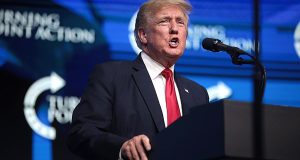By Lincoln Depradine
Pride Contributing Writer
Political upheaval and confusion have been major highlights of the history of the Tri-island Nation of Grenada, Carriacou and Petite Martinique ever since it gained independence from Britain on February 7, 1974.
What has transpired in the last 40 years should, in some ways, have been expected; there was ominous foreshadowing.
The birth of the nation was ushered in during a national crisis. And, we can go even farther back to the struggles against colonial incursion by the first inhabitants, the Kalinagos or Caribs; the uprising against British rule by Julien Fedon in 1795; and the “Sky Red’’ working class protest led by Eric Matthew Gairy in 1951.
Gairy, again, was to feature prominently in the lead up to Grenada’s independence in 1974. Criticism of his running of the country had been intensifying, especially from young university-educated Grenadians such as Maurice Bishop and Unison Whiteman, who were organizing themselves into group such as Movement for the Assemblies of the People (MAP) and Joint Endeavour for Welfare, Education and Liberation (JEWEL).
MAP and JEWEL eventually merged to form the New Jewel Movement (NJM).
Then Premier Gairy won general elections in 1972. He committed himself to taking Grenada into independence, and the prospect frightened many that felt it would give Gairy leeway for even more government excesses and abuse.
There were repeated complaints of beatings by Gairy’s paramilitary “Mongoose Gang’’; lack of employment and educational opportunities for those considered anti-Gairy; and government victimization of workers in hiring and promotion.
The concerns of the population were taken up by a broad-based group – called the Committee of 22 – that included business people, the clergy and labour leaders. By January 1974, Gairy was also confronting daily street protests of hundreds.
On January 21, the protests took a deadly turn. That day, a march on the Carenage in St George’s was invaded and broken up by Gairy supporters, including police and Mongoose Gang members.
Shots were fired at demonstrators who had taken refuge in a trade union building, where a live recording of the onslaught was captured by the late Grenadian journalist Alister Hughes. Several people were injured in the melee and one lost his life – Rupert Bishop, father of Maurice Bishop.
Looting of stores also ensued on January 21, widely known in Grenada as “Bloody Monday’’.
The “Bloody Monday’’ events did not stop the protests and Grenada went into independence under a nationwide strike, an electricity blackout and a shutdown of the main seaport. The nation was in darkness as the new red, green and gold flag of Independent Grenada was hoisted at Fort George in 1974.
Gairy’s rule ended with the NJM-led 1979 Revolution, the first armed overthrow of a government in the modern English-speaking Caribbean.
The Revolution, while popular among large segments of the population for its social programs, brought its own internal and external tensions, particularly with the United States.
The social experiment imploded in 1983 with the killing of then Prime Minister Maurice Bishop and others by members of the People’s Revolutionary Army. The United States invaded the country and a new order began with the installation of an Interim Administration.
The political space, in pre-independent Grenada, was occupied by Gairy’s Grenada United Labour Party (GULP) and the Grenada National Party of the late Herbert Blaize. In post-invasion Grenada and until now, it has been the New National Party (NNP) and the National Democratic Congress (NDC). In the beginning, 1984, the two were one – all the political players were members of the NNP. No NDC existed as yet.
Then, in 1987, disagreement and disgruntlement led to a breakaway NNP faction forming the NDC.
Two years later, Dr Keith Mitchell successfully challenged Herbert Blaize for leadership of the NNP.
Blaize left Mitchell with the NNP. Prime Minister Blaize established the shortlived TNP – The National Party – to run the country and government.
TNP, which was led by Ben Jones after Blaize’s death, disappeared from the landscape after losing general elections in 1990.
The NDC formed the government in 1990 and served one term. It was a one-term government again from 2008 to 2013.
The NNP under Dr Mitchell has fared much better, controlling the seat of government from 1995 to 2008; and returning to office a year ago with a 15-0 clean sweep of the NDC.
As Grenada celebrates 40 years of independence, it is also marking three decades of polarized and tribalized NDC/NNP politics. Bitter acrimony, even hatred, has precluded national consensus on any issue.
A lot of the energy expended in fighting daily petty political battles could better be utilized reforming the country’s institutions to make them more nimble and responsive to the people.
There are too many laws, for example, that are holdovers from Medieval England and the plantation slave system that still remain and ought to be struck off the books.
Some people also are deeply concerned about students graduating from secondary schools with more subjects than ever before in the country’s history, but say too many are unable to handle the requirements of simple Math and English in the workplace.
For me, I keep wondering why there is more money in sports today, but Grenada national teams of the past won more consistently when sportsmen played cricket and football barefooted.
Gairy, once reviled and condemned, is being relooked with 40 years of hindsight. Independence is now broadly embraced; it has become a genuine major national celebration and Gairy is commonly referred to as “The Father of Independence’’.
I have heard it said by Gloria Payne-Banfield, a known Gairy supporter and fount of Grenadian political and cultural history, that there was no Mongoose Gang. For sure, the Mongoose Gang wasn’t formal in the sense of having a president, secretary and treasurer. But they were as real as the falling snow in Toronto, and Gairy was fully aware of their existence and green lighted them.
I would say to Payne-Banfield that you can be a proud Gairyite without defending the Mongoose Gang. All Grenada’s governments – including Gairy’s GULP – have done some bad and some good.
I suspect those close to Gairy were giving him bad advice, and Gairy himself underestimated the strength of his support base. In my opinion, he didn’t need to resort to brute force in the face of mounting opposition.
Overall, in the period Gairy was in office, he demonstrated that he had a faith that Grenada – though small – possessed an immense capacity to do bigger things. He wasn’t a leader either who was stymied and paralyzed by doing.
Gairy wanted to host a general assembly of the Organization of American States in Grenada, he acted and it happened. He wanted to host a cultural expo, he acted and it happened.
People elect a government to act; it’s not enough to say, “Trust us – we’re working for you behind the scenes.’’ People elect a government to do things they can’t do for themselves. You can fault Bishop’s People’s Revolutionary Government for many things, but not for trying.
In February, the NNP will be celebrating one year since its triumphant return to government. And the NDC will meet to elect a new party executive and leader.
But whether in government or opposition, the challenge of politicians and parties remains the same as it was at independence 40 years ago: buckling down and coming up with practical ideas, and policies and programs, that ought to be implemented to lift the living standards of the people of Grenada, Carriacou and Petite.
 Pride News Canada's Leader In African Canadian & Caribbean News, Views & Lifestyle
Pride News Canada's Leader In African Canadian & Caribbean News, Views & Lifestyle




